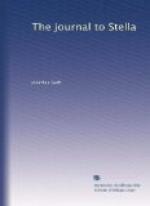10 St. Albans Street, Pall Mall, was removed in 1815 to make way for Waterloo Place. It was named after Henry Jermyn, Earl of St. Albans.
11 Ben Portlack, the Duke of Ormond’s secretary.
12 Algernon Seymour, Earl of Hertford (1684-1750), only son of Charles Seymour, Duke of Somerset. Lord Hertford succeeded to the dukedom in 1748. From 1708 to 1722 he was M.P. for Northumberland, and from 1708 to 1713 he took an active part in the war in Flanders.
13 See Letter 4.
14 A Short Character of the Earl of Wharton (see Letter 10. note 29).
15 See Letter 9.
16 Henry Herbert, the last Baron Herbert of Cherbury, succeeded to the peerage in 1709, and soon afterwards married a sister of the Earl of Portsmouth. A ruined man, he committed suicide in 1738.
17 Nos. 257, 260.
18 See Letter 6, note 12.
19 “After is interlined” (Deane Swift).
20 With this account may be compared what Pope says, as recorded in Spence’s Anecdotes, p. 223: “Lord Peterborough could dictate letters to nine amanuenses together, as I was assured by a gentleman who saw him do it when Ambassador at Turin. He walked round the room, and told each of them in his turn what he was to write. One perhaps was a letter to the emperor, another to an old friend, a third to a mistress, a fourth to a statesman, and so on: yet he carried so many and so different connections in his head, all at the same time.”
21 Francis Atterbury, Dean of Carlisle, had taken an active part in the defence of Dr. Sacheverell. After a long period of suspense he received the appointment of Dean of Christ Church, and in 1713 he was made Bishop of Rochester and Dean of Westminster. Atterbury was on intimate terms with Swift, Pope, and other writers on the Tory side, and Addison—at whose funeral the Bishop officiated—described him as “one of the greatest geniuses of his age.”
22 John Carteret, second Baron Carteret, afterwards to be well known as a statesman, succeeded to the peerage in 1695, and became Earl Granville and Viscount Carteret on the death of his brother in 1744. He died in 1763. In October 1710, when twenty years of age, he had married Frances, only daughter of Sir Robert Worsley, Bart., of Appuldurcombe, Isle of Wight.
23 Dillon Ashe, D.D., Vicar of Finglas, and brother of the Bishop of Clogher. In 1704 he was made Archdeacon of Clogher, and in 1706 Chancellor of Armagh. He seems to have been too fond of drink.
24 Henley (see Letter 6, note 15) married Mary, daughter of Peregrine Bertie, the second son of Montagu, Earl of Lindsey, and with her obtained a fortune of 30,000 pounds. After Henley’s death his widow married her relative, Henry Bertie, third son of James, Earl of Abingdon.
25 Hebrews v. 6.
Letter 13.
1 Probably Mrs. Manley and John Barber (see Letter 11, note 28 and Letter 12, note 6).




